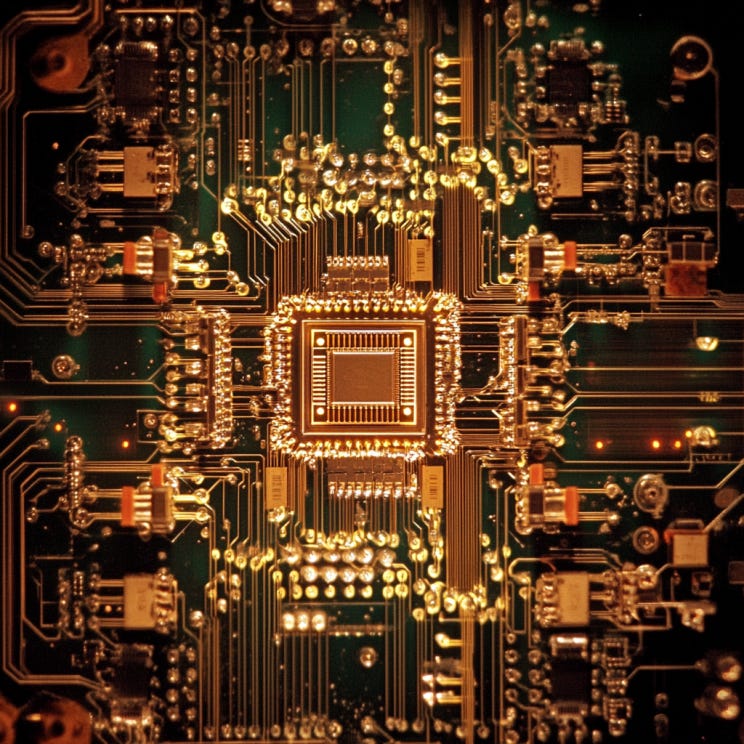Bitcoin vs. Quantum Computing Hack: BTC Attack Risk Analysis
Is Bitcoin (BTC) currently vulnerable to a quantum computer hack? Not really... mostly just "FUD"
Most people have zero damn clue what quantum computing actually is/does.
The most common ideas re: quantum are: (1) pseudoscientific magic (e.g. astral traveling through a parallel universe for chakra alignment) and (2) NVIDIA killers (quantum > GPUs).
Recently the hype for quantum had been heavily percolating due to pure-play quantum stocks going up (IonQ, Rigetti, D-Wave)… when stocks go up, hype gets insane.
However, Google poured gasoline on the hype fire by announcing “Willow” – their newest and most advanced quantum chip which allegedly completes calculations in under 5 minutes that would take 10 septillion years to complete with classical supercomputers.
Anyways, now the Bitcoin (BTC) community is faced with more “quantum computing” FUD (fear, uncertainty, doubt) re: their investments.
Why? Because if an advanced quantum computer is developed in the near future, it could potentially hack the Bitcoin network and render BTC worthless or slowly drain select wallets to cash out (while maintaining the guise that BTC is still “digital gold”).
What are the odds that a quantum computer hacks the Bitcoin (BTC) network?
The odds of a successful large-scale quantum attack on the Bitcoin network in the foreseeable future (on the order of 10–20 years) is extremely low, but probably not zero.
Current estimates of quantum hardware progress, combined with Bitcoin’s capacity for cryptographic upgrades, indicate that risk can be contained with proactive development.
1. State of Quantum Computing Progress
Current Quantum Capability: Presently available quantum computers (2024) have on the order of a few hundred noisy qubits. Breaking Bitcoin’s elliptic curve cryptography (ECC) would likely require on the order of millions of logical, error-corrected qubits. We are far from this hardware scale.
Roadmap & Timeline: Achieving a quantum computer capable of reliably factoring or attacking ECC keys at the required scale is widely estimated to be at least 10–15 years away, often cited as a “post-2035” concern. Even this timeframe may be optimistic; practical large-scale quantum computing remains an engineering and scientific challenge on multiple fronts.
Error Correction & Scalability: The crucial barrier is not just raw qubit count but fault-tolerant error correction and coherence times. Achieving fault tolerance at scale has proven to be one of the toughest hurdles. Progress is steady but incremental, suggesting that the timeline for a truly threatening machine could easily slip beyond two decades.
2. Cryptographic Vulnerability in Bitcoin
Current Bitcoin Security Model: Bitcoin uses the ECDSA (secp256k1) signature scheme. The fundamental vulnerability to quantum computers lies in the discrete logarithm problem, which Shor’s algorithm can theoretically solve efficiently given a powerful enough quantum machine.
Address Reuse and Exposure: Private keys are derived from exposed public keys. Bitcoin’s best practice discourages address reuse, and private keys remain hidden until a transaction is made. Thus, not all coins are equally at risk. Attackers would mainly target addresses known to have significant funds whose public keys have been revealed.
Future Cryptographic Upgrades: The Bitcoin community has the capacity to implement soft forks or hard forks to transition to quantum-resistant signature schemes (e.g., based on lattice cryptography). This is a social, technical, and political challenge, but not an impossible one. Given enough warning and consensus, upgrades can be deployed well before a live quantum threat materializes.
3. Preventative Measures & Adaptation Speed
Network Upgrades: The Bitcoin developer community is aware of the quantum threat. Discussions and research into quantum-secure cryptographic schemes have already begun. If credible signs of impending quantum capability arise, the Bitcoin network, known for its resilience and adaptability (albeit slow), can roll out new protocols within a few years.
Gradual Migrations: The network could gradually transition funds to quantum-safe addresses. Since only addresses that have revealed their public keys are vulnerable, users could preemptively move their funds to upgraded addresses once a quantum-safe upgrade is available.
Odds the BTC Blockchain gets Hacked (Estimated)
Considering the current state of quantum computing (including the latest Google “Willow” breakthrough) odds that BTC network gets hacked are insanely low.
They are so low that I’d be comfortable parking all of my money in a bet that there would be no hack of the Bitcoin cryptography (assuming high ROI potential on the bet).
Short Term (Next 5–10 Years): <1%
Medium Term (10–20 Years): Depends on whether they fork the network. They likely will to allay quantum hack concerns before this becomes a possibility.
Without Preventative Action: As quantum technology matures, let’s assume a modest chance that by the mid-2040s a sufficiently large and stable quantum computer could exist. If, hypothetically, Bitcoin took no action at all, the probability might rise, perhaps to around 5–10%. This scenario assumes stagnation in network upgrades, which is unlikely given the existential threat posed by quantum attacks.
With Preventative Actions: If the Bitcoin community upgrades cryptography in a timely manner (e.g., within a decade from now), the risk effectively drops back towards negligible levels, probably <1%.
How confident am I in these odds (quantum hack within the next ~10y)?
Very. But anything can happen. I’m not 100% because that’s unrealistic.
I’d say I’m 80-90% confident that odds are under <1% that the Bitcoin network cryptography is hacked in the next 5-10 years.
Over a longer-term horizon, I’m less certain - many things can happen, but I’d say if BTC network is forked for quantum-resistance, odds drop back to <1% of a quantum hack over the next 20 years.
I guess it all comes down to whether the rate of quantum progress outpaces the BTC Network’s ability to stay one step ahead.
Rationale for the estimates:
These probabilities are not exact scientific measurements but reasoned assessments based on the current understanding of quantum computing progress curves, cryptographic research, and Bitcoin’s demonstrated ability to adapt to critical threats.
The Bitcoin ecosystem is not technologically static. It has previously managed upgrades (albeit gradually) such as SegWit and Taproot.
A quantum threat, if proven imminent, would be a strong motivator for even more urgent upgrades.
Quantum computing timelines have historically been pushed forward optimistically; breakthroughs often take much longer than initial forecasts suggest.
While a quantum computer poses a theoretical threat to Bitcoin’s current cryptography, the odds of a successful large-scale quantum hack occurring before countermeasures are implemented are quite low.
A rough, subjective estimate might place the probability at under 5% over the next two decades, if zero actions are taken.
With active efforts to implement quantum-resistant cryptography, that probability becomes negligible.
The confidence in these assessments is moderate to high for the short term and more uncertain for very long-term horizons.
What if a quantum attacker breaks Bitcoin’s cryptography? (Possible outcomes)
If a quantum attacker gained the capability to break Bitcoin’s cryptography, their next move would be influenced by economic incentives and the potential repercussions.
Some might be benevolent and not care about the profit potential such that they’d notify BTC holders that a network upgrade is needed.
A rational quantum attacker with a profit motive would probably not want to take down the entire Bitcoin network outright.
They would more likely engage in selective theft, extortion, or market manipulation, in ways that preserve the network’s underlying value while extracting wealth.
Full-scale destruction of Bitcoin would diminish their own potential gains, so more nuanced strategies are likely.
However, motivations can vary, and non-financial goals (such as ideological sabotage or geopolitical interests) might lead an attacker to behave differently.
It’s reasonable to assume that the entity capable of hacking BTC cryptography before BTC forks to quantum resistance probably won’t be nefarious.
Why? Probably some team of nerds or person who is already rich - not much to gain.
It’s possible that a large country (e.g. China) or fleet of AIs could use it to sabotage another country (e.g. U.S. with the most holders).
Highest risk would be if a country like China went all in on quantum and advanced covertly and much faster than the U.S.
1. Stealing All the BTC vs. Selective Theft
Stealing Everything: If the attacker managed to grab a large fraction of the total Bitcoin supply, they would likely crash the price, rendering their newly acquired coins far less valuable. A sudden, large-scale theft would erode market confidence and destroy the scarcity that gives Bitcoin its value. In other words, “killing the golden goose” by making off with the entire network’s funds would undermine their own potential profit.
Selective, Targeted Theft: A more sophisticated quantum attacker might be subtle. Instead of going after all Bitcoin at once, they might target high-value wallets that are known to contain large balances, particularly those that have revealed their public keys. By stealing moderate amounts over time, they could launder the proceeds and maintain the façade of a functioning market, potentially reaping more value. They might also spread out their attacks to avoid drawing immediate, catastrophic attention.
2. Ransom or Hostage Scenario (?)
Demanding Payment Not to Attack: The attacker might threaten to publish a quantum exploit or to systematically drain high-profile wallets unless the community (or major stakeholders such as custodians, exchanges, or wealthy holders) pays a ransom. This hostage scenario could extract value without having to destroy the entire network.
Attacking Infrastructure Components: Instead of directly stealing Bitcoin, an attacker might prove their capabilities by breaking a few well-secured wallets and then demand ongoing payments in exchange for not escalating the attack. This could result in a form of “extortion-as-a-service,” where they exploit fear to extract wealth over time.
3. Market Manipulation & Secondary Gains
Short Selling and Panic Profiteering: Another angle might be indirect. The attacker could open massive short positions on Bitcoin derivatives markets, then reveal or threaten an attack, causing the price to plummet. They wouldn’t even need to steal a single coin; market fear and panic could yield significant profits from their well-timed short trades.
Undermining Competing Systems or Entities: In a geopolitical or corporate espionage scenario, a well-funded attacker might aim to discredit and damage Bitcoin without profiting directly from the theft. The motive might be sabotage, discouraging usage, or shifting investment flows into other assets or currencies.
4. Long-Term Considerations
Incentive to Maintain Value: If the attacker values maximizing returns, they’ll likely try to avoid a full “rug pull.” Bitcoin only holds value if the market believes it’s secure and scarce. Destroying trust too thoroughly is counterproductive to any sustained profit motive.
Negotiated Settlements or Bounties: There might be scenarios where the attacker discloses vulnerabilities in return for large bounties, essentially selling their quantum “zero-day” knowledge rather than using it destructively. Some entities—major Bitcoin stakeholders or even governments—might pay to keep the system intact.
How long before Bitcoin holders detect a quantum hack?
A truly rational and capable quantum hacker with a profit motive would likely attempt to blend into the noise of everyday theft and normal market dynamics.
By staying under the radar and avoiding dramatic heists, they might remain undetected for a long time.
Without a clear, unmistakable quantum “signature” to the thefts, the Bitcoin community might not realize for months—or even years—that a quantum-capable adversary is quietly exploiting vulnerabilities.
You’d likely read about people losing Bitcoin (BTC) from their storage wallets on X/Twitter – and readers would assume they made some sort of error (e.g. shared their private keys on accident).
Selective, Low-Profile Thefts: By targeting smaller amounts or moving funds incrementally, the attacker can avoid drawing immediate attention. Wallets are lost or compromised all the time due to mundane reasons (phishing, poor key management, insider theft). If thefts resemble typical cybercrime patterns, the community may not immediately suspect a quantum capability.
Obfuscation via Mixing and Laundering: After stealing coins, the attacker could use mixers, tumblers, privacy-centric blockchains, or layered transactions to obfuscate the stolen funds’ origins. Such practices are already common among cybercriminals, and blending in with normal illicit activity would make it difficult to pinpoint a uniquely “quantum” attack.
Maintaining Market Confidence: A rational hacker who wants the value of their stolen BTC to remain high has an incentive to avoid causing a panic. If they tip their hand too early—by grabbing a legendary trove of coins (like those tied to known large addresses) all at once—market confidence would be shattered. A gradual approach keeps prices steadier, maximizing long-term profits.
Exploiting Dormant Addresses or Old Keys: Some addresses hold large amounts of BTC and haven’t been active for years. A clever attacker might first experiment on small targets or even dormant wallets to see if anyone notices. If coins move from a long-inactive address, it could be dismissed as a forgotten holder finally cashing out, rather than a quantum hack.
Delay and Denial of Technical Proof: Even if cryptographic anomalies were suspected—such as the cracking of a highly secure address—proving that it was due to quantum computation would be difficult. Doubt, speculation, and competing explanations (like leaked private keys) could delay a consensus that a quantum hack occurred.
Types of Quantum Computers for Breaking Bitcoin’s Cryptography
The type of quantum computer required is a large-scale, fault-tolerant, universal gate-based system—something currently not in existence.
Nonetheless, as these organizations continue to refine their technologies, the eventual realization of such machines can’t be dismissed.
Universal, Gate-Based Quantum Computers: To run Shor’s algorithm, which can break RSA and elliptic curve cryptography (including what Bitcoin uses), you need a universal, fault-tolerant quantum computer.
Such a system must:
Support a large number of logical qubits (on the order of millions of physical qubits, due to error correction overhead).
Allow the execution of complex gate sequences with extremely low error rates.
Implement comprehensive quantum error correction to achieve stable logical operations.
Superconducting Qubits (e.g., IBM, Google): This approach currently leads in terms of investment and engineering maturity. While they have made great strides, scaling to the required size for a Bitcoin-breaking machine is still a major challenge.
Trapped Ion Qubits (e.g., IonQ): Ion-based systems have very high fidelity and long coherence times, making them attractive for error correction. This could mean fewer physical qubits are needed compared to superconducting systems, if the error rates are inherently lower.
Photonic Qubits (e.g., PsiQuantum): Photonic approaches aim for massive scalability by relying on integrated photonics. If they can solve the challenges in fault tolerance, photonic quantum computers might eventually offer the immense scale needed to break cryptographic systems.
Topological Qubits (e.g., Microsoft’s Research): If successfully realized, topological qubits might inherently have lower error rates, reducing the overhead of error correction. This could make breaking cryptography more feasible by scaling with fewer physical resources.
What Won’t Help Much:
Quantum Annealers (e.g., D-Wave Systems): Quantum annealers are good for optimization problems but cannot run the general quantum algorithms like Shor’s that are required to break cryptographic keys. They don’t provide the universal gate set or error-corrected environment to tackle the discrete logarithm problem efficiently.
What about combining quantum computers with NVIDIA GPUs via CUDA-Q to hack Bitcoin?
Tools like NVIDIA’s CUDA Quantum (CUDA-Q) and powerful GPUs can accelerate quantum computing research and hybrid algorithm development, they do not provide a shortcut to achieving the large-scale, fault-tolerant quantum hardware required to crack Bitcoin’s cryptography.
The quantum threat to Bitcoin hinges on building and operating a true quantum computer at scale, a challenge that remains orders of magnitude more difficult than classical acceleration can solve.
As a result, the existence of GPU-accelerated quantum frameworks does not significantly shift the timeline or likelihood of a near-term quantum attack on Bitcoin.
But isn’t quantum computing progressing exponentially like Moore’s law?
No. Qubit numbers and quality have improved, but the progress does not resemble an unbroken exponential growth in capability.
For example, going from a dozen qubits to a few hundred is substantial but still nowhere near the millions of qubits needed to run a large instance of Shor’s algorithm that could threaten Bitcoin’s elliptic curve cryptography.
Each stage of scaling faces new “bottlenecks” that slow progress—cryogenic cooling limits, fabrication yields, error correction overhead, and so forth.
One of the biggest barriers is quantum error correction.
Even if raw qubit counts grow, error-corrected “logical qubits” (the building blocks needed for practical large-scale algorithms) may not grow nearly as fast.
The overhead in terms of the number of physical qubits required per logical qubit is enormous—likely in the thousands.
Improving error rates, creating better qubit architectures, and developing robust fault-tolerant protocols are slow, research-intensive processes.
They don’t scale easily in an exponential “plug-and-play” manner.
Quantum computing timelines have often been overly optimistic.
Predictions made 5–10 years ago that we would have fault-tolerant, general-purpose quantum machines by the early 2020s have proven premature.
While progress is steady and non-trivial, it’s more iterative than explosively exponential.
Lastly, there are so many different quantum technologies (superconducting qubits, ion traps, photonic qubits, topological qubits) all of which scale differently.
Note: There is somewhat of a “Moore’s Law” for quantum annealers called “Rose’s Law” but annealers aren’t universal quantum computers. Even if they scale rapidly they don’t threaten BTC’s cryptography.
What will the Bitcoin network do to become quantum-resistant (2025-2050)?
Over the next three decades, Bitcoin’s approach to the quantum threat likely moves from theoretical preparation to partial adoption of quantum-safe keys, and ultimately to a mandatory network-wide transition.
The evolution will be deliberate and slow at first, picking up pace as the quantum threat becomes more tangible.
By 2050, if quantum computing advances as some predict, Bitcoin will have already reinvented its cryptographic foundations to maintain its security and trust.
2025–2030:
Research and Awareness:
The Bitcoin developer community, cryptographic experts, and industry stakeholders continue deepening their understanding of quantum-resistant algorithms.
Academic papers and Bitcoin Improvement Proposals (BIPs) explore lattice-based or hash-based signature schemes as potential post-quantum cryptographic standards.
No Immediate Upgrades Yet:
Since quantum computers capable of breaking ECDSA are not imminent, the network does not rush to adopt quantum-resistant signatures. Instead, it lays groundwork—draft specifications, test reference implementations, and establish code auditing practices.
Wallet developers begin providing “optional quantum-safe keys,” but only as experimental features.
2030–2035:
Preemptive Protocol Additions:
Growing confidence in certain post-quantum cryptographic primitives leads to a BIP proposing optional quantum-resistant addresses (QRA) that users can adopt on a voluntary basis.
Exchanges, custodians, and institutional holders start moving a fraction of their funds into QRA to hedge against future threats.
Soft Fork Implementation (If Consensus Reached):
A soft fork introduces native support for a quantum-resistant signature scheme alongside the existing ECDSA. These “hybrid” addresses allow Bitcoin to run two cryptographic systems in parallel.
The majority of users still rely on legacy addresses, but a slow, organic migration begins. Educational efforts from major wallet providers guide users to create “future-proof” wallets for their long-term holdings.
2035–2040:
Market-Driven Migration:
Rumors of significant advances in quantum computing—large-scale error-corrected qubit systems appearing on the horizon—prompt more serious attention.
Over this period, at least 30–50% of Bitcoin’s circulating supply transitions to quantum-resistant addresses. Long-term HODLers, institutional investors, and pension funds holding BTC ensure their security is future-proofed.
Consensus on a Network Transition Plan:
The Bitcoin community begins discussing a “flag day” or soft/hard fork date after which newly mined blocks or newly spent coins must use quantum-resistant keys. Several competing proposals emerge, reflecting the social layer’s complexity.
2040–2045:
Mandatory Quantum-Safe Enforcement (If Threat Materializes):
By now, it’s clearer that quantum computers can feasibly break old ECDSA keys within a few weeks or days if they have large enough logical qubit counts. Although no confirmed hack has occurred, the credible threat catalyzes action.
A planned network upgrade (possibly a soft fork with broad consensus or, if urgently needed, a controversial hard fork) mandates that any transaction spending from legacy addresses must transition to quantum-safe outputs.
Dust and Dormant Funds:
Addresses that remain on old keys eventually become at-risk. The network sets a multi-year grace period, after which legacy script types may be considered non-standard or even invalid.
This controversial move leads to community debates, but most users comply to protect their funds.
2045–2050:
Full Quantum-Resistant Network:
By the mid-to-late 2040s, the overwhelming majority of BTC is held behind quantum-resistant keys.
The Bitcoin Core reference client (and most widely used implementations) treat quantum-resistant cryptography as the default standard. ECDSA is preserved historically but no longer recommended or widely used for active wallets.
Ongoing Security Audits and Algorithmic Agility:
The network adopts a more “algorithmically agile” posture, enabling future cryptographic upgrades without the same level of friction. Lessons from the quantum transition inform a new culture of proactive upgrades.
Ongoing research ensures that if future quantum improvements threaten even the chosen post-quantum algorithms, Bitcoin can pivot more gracefully.
Post-2050 Outlook:
By 2050, Bitcoin has likely fully integrated and matured around quantum-resistant cryptography. The social, technical, and economic cost of this transition was significant, but the network remained intact.
New best practices for key management, hardware wallets designed around post-quantum schemes, and enhanced consensus mechanisms ensure that the quantum threat is manageable rather than existential.
If the Bitcoin network is upgraded be quantum-resistant will holders need to do anything?
If you self-custody on legacy keys, you’ll eventually need to move your coins to a quantum-resistant address once that upgrade is widely supported.
If you use a third-party custodian, they will likely handle it for you.
In either case, the transition is likely to be guided, well-communicated, and spaced out over enough time that users can adapt without rushing.
If You Self-Custody and Control Your Own Keys: If you hold your own private keys on legacy addresses (e.g., those using ECDSA), you may eventually need to move your funds to newly generated, quantum-resistant addresses.
If You Use Third-Party Services (Exchanges, Custodians): If you store your Bitcoin with a reputable exchange, custodian, or professionally managed wallet service, that provider would probably handle the technical aspects of upgrading. They could automatically move your funds into quantum-resistant storage on your behalf. In this case, you might not need to do anything except ensure you trust the service to implement updates correctly.
Network-Level Upgrades (Soft/Hard Fork): Network upgrades that introduce quantum-resistant addresses would likely be introduced via a mechanism that maintains compatibility for a period of time. Users wouldn’t be forced to move immediately, but there could be a “flag day” years down the road after which old address formats are no longer recommended or recognized.
Community Education and Support: By the time quantum resistance is deemed necessary, wallet developers, industry groups, and Bitcoin core contributors will have published extensive guides, best practices, and user-friendly tools to help non-technical holders make the transition smoothly.
Could Bitcoin be hacked by a massive supercomputer with elite engineers?
Even a massively scaled “ultimate supercomputer” incorporating classical supercomputers, GPUs, neuromorphic chips, and nascent quantum hardware isn’t currently thought to be capable of breaking Bitcoin’s cryptography.
Without a fully realized, large-scale, fault-tolerant quantum computer that can run Shor’s algorithm, such a system would be incredibly powerful but still fall short of what is needed to break ECDSA at the core of Bitcoin’s security.
1. Classical Computing Limits:
Discrete Logarithm Complexity: Bitcoin’s security rests on the hardness of the elliptic curve discrete logarithm problem (ECDLP). There is no known classical algorithm that solves ECDLP in polynomial time. Even if you combine thousands of GPUs, custom ASICs, and cutting-edge CPUs into a supercluster, the complexity of brute-forcing a private key remains astronomically high.
Scaling Doesn’t Solve the Core Problem: Adding more compute power reduces the time for brute force slightly, but not from an astronomical timeframe to a practical one. The keyspace is still so large (roughly on the order of 2^128 operations for breaking a 128-bit security level) that no realistic classical supercomputer can reduce this to manageable durations—certainly not to days, years, or even centuries.
2. Neuromorphic and Other Exotic Hardware:
Specialized Hardware, Same Complexity Class: Neuromorphic chips mimic brain structures and are good for pattern recognition and certain specialized tasks. They do not provide known algorithmic shortcuts for discrete logarithms or factoring large numbers. There’s no evidence that neuromorphic architectures fundamentally change the complexity class of ECDLP.
Niche Improvements, Not Algorithmic Breakthroughs: Such hardware might accelerate certain heuristics or guesswork, but without a new mathematical insight or algorithm that drastically lowers complexity, these architectures won’t magically solve the underlying cryptographic problem.
3. Quantum Interfaces and “Partial” Quantum Tech:
Half Measures Don’t Help: A small-scale quantum device or a “quantum-accelerated classical system” that isn’t fully fault-tolerant and doesn’t have enough qubits for Shor’s algorithm on large keys doesn’t get you to a meaningful cryptographic break.
Incremental Quantum Hardware: Partial quantum power doesn’t let you factor large integers or solve large discrete logs at the scale required to crack Bitcoin’s keys.
4. Algorithmic Breakthroughs Are the Game-Changer:
Need a New Algorithm: If a revolutionary algorithm were discovered that undermined ECDLP, that would be more important than any hardware assembly. With current known algorithms, no classical or hybrid classical-quantum approach at small scale can break Bitcoin-level cryptography. It’s the mathematics, not just the hardware, that’s the barrier.
Shor’s Algorithm Requires Real Quantum Scale: The known quantum approach is Shor’s algorithm. It requires a large, stable, fault-tolerant quantum computer—something far beyond current or near-future prototypes, no matter how clever the hybrid integration.
5. Defensive Upgrades of Bitcoin:
Even if a Machine Emerged: By the time it’s plausible that such a super-assembly of classical and early quantum hardware could threaten Bitcoin, the Bitcoin network and ecosystem would likely have transitioned to quantum-resistant cryptographic schemes. This proactive defense further undercuts the feasibility of an ultimate supercomputer hacking Bitcoin.
Could an elite team of software engineers hack Bitcoin with unlimited resources?
Even an immensely large and well-funded team equipped with a billion state-of-the-art GPUs would almost certainly fail to break Bitcoin’s cryptographic keys in any practical timeframe using currently known methods.
The sheer mathematical complexity of the underlying cryptography is so vast that no amount of classical compute scaling, at least with known algorithms, would bring the task down to a feasible duration.
1. The Underlying Mathematical Problem
Bitcoin’s security rests on the elliptic curve discrete logarithm problem (ECDLP). Solving ECDLP for the curve secp256k1 (used by Bitcoin) is known to require on the order of 2^128 operations with classical methods.
This number is astronomically large—roughly 3.4 × 10^38 operations.
2. Scaling Up Classical Compute Power
Let’s consider a fantastical scenario:
1 Billion (10^9) Top-Tier GPUs:
Modern high-end GPUs can execute on the order of 10^14 to 10^15 floating point operations per second (FLOPS) under ideal conditions.
Let’s assume optimistically that cryptographic operations can be parallelized and efficiently harness this capability (a big assumption, as real-world performance would be lower).
If each GPU performs about 10^15 operations/second, and you have 10^9 GPUs, that’s 10^24 operations/second in total (10^15 ops/s × 10^9 GPUs = 10^24 ops/s).
3. Comparing Operations per Second to Required Work
With 10^24 ops/s, how long to do 3.4 × 10^38 operations?
Time = 3.4 × 10^38 ops ÷ 10^24 ops/s = 3.4 × 10^14 seconds.
There are about 3.15 × 10^7 seconds in a year, so: 3.4 × 10^14 seconds ÷ 3.15 × 10^7 s/yr ≈ 10^7 years (ten million years).
Even with generous assumptions, this is still millions of years.
Realistically, cryptographic operations (involving big integer arithmetic and special data structures) would be slower than raw FLOPS, and you wouldn’t achieve perfect parallelization or efficiency.
4. Algorithmic Constraints
The bottleneck isn’t just raw compute—it’s the absence of a known classical algorithm that breaks ECDLP in sub-exponential or polynomial time.
Without a dramatically better algorithmic approach, more hardware just scales the brute force, which remains infeasible.
5. Technological Improvements Each Year
Even if NVIDIA improves GPUs each year, the improvement would be incremental—maybe doubling performance every 1–2 years (which is already optimistic).
Doubling performance repeatedly to beat a time horizon of millions of years would still leave you astronomically far from success.
Hardware improvements alone can’t overcome the fundamental exponential complexity.
6. No Shortcut from Large-Scale Engineering
Even a team like OpenAI, known for optimizing algorithms and large-scale computing solutions, cannot transform an exponential-time cryptographic problem into a tractable one through brute force.
Significant breakthroughs in cryptanalysis or quantum computing would be required.
Quantum Considerations…
Without a large-scale, fault-tolerant quantum computer implementing Shor’s algorithm, classical supercomputing approaches remain futile.
A billion GPUs doesn’t get you a shortcut to the polynomial-time solution that quantum computing promises.
You need actual quantum hardware at scale, not just more classical silicon.
No matter how large you scale classical computing—be it with GPUs, CPUs, specialized chips, or neuromorphic hardware—current knowledge and math place Bitcoin’s cryptographic challenge far beyond reach.
Even a massive engineering feat powered by top talent and endless budgets isn’t enough to brute-force Bitcoin’s keys in any reasonable timeframe.
Are there any ways to crack Bitcoin without quantum computing?
A fundamental mathematical or cryptanalytic breakthrough would be the true game-changer—well above any known computing paradigm.
Without quantum computing, other advanced or exotic computing models do not currently offer known shortcuts to breaking Bitcoin’s cryptography.
If forced to rank hypothetical non-quantum methods, a major theoretical algorithmic breakthrough tops the list.
Next, various exotic computational paradigms might help only if they somehow leverage parallelism or new physics to achieve what classical and neuromorphic approaches cannot.
However, no known or even theorized non-quantum technology currently provides a clear path to solving the elliptic curve discrete logarithm problem (ECDLP) efficiently.
1. A Major Mathematical/Cryptanalytic Breakthrough (Algorithmic Discovery)
What It Is: Finding a new algorithm that solves ECDLP in polynomial time on a classical computer without relying on quantum effects. This would be akin to discovering a shortcut that mathematically undermines the hardness assumption that Bitcoin’s security relies on.
Why It’s Top: Such a breakthrough doesn’t depend on hardware. It instantly renders existing cryptography obsolete, even on modest computing resources. This is the ultimate key—if you have a radically more efficient algorithm, scaling up hardware becomes trivial.
Likelihood: Extremely low based on current knowledge, but not impossible. Historically, major cryptanalytic breakthroughs are rare and often considered improbable by experts.
2. Molecular/DNA Computing
What It Is: DNA computing and other biochemical or molecular approaches can, in theory, offer massive parallelism. Billions of molecules can interact simultaneously, providing a brute-force approach that might search keyspaces more efficiently than classical silicon-based machines.
Pros: Massive parallelism could, in principle, reduce search times for certain problems if they can be encoded into molecular reactions.
Cons: Managing errors, reading out results, and scaling to the astronomically large keyspaces required for ECDLP remains daunting. DNA computing doesn’t magically solve exponential complexity—it just parallelizes brute force.
3. Photonic or Optical Computing
What It Is: Light-based processors can, in some scenarios, perform certain computations at extremely high speeds and parallelism.
Pros: Photons can travel and interact very fast, and optical neural networks or optical matrix multipliers can outperform classical chips on some linear algebra tasks.
Cons: Cryptographic discrete logarithms don’t simplify easily into operations that photonic hardware can solve exponentially faster. Without a suitable algorithmic trick, optical computing’s speedups are at best polynomial and still face the exponential complexity barrier.
4. Neuromorphic Computing
What It Is: Neuromorphic chips mimic the structure of biological neural networks, potentially excelling at pattern recognition, approximate optimization, and certain heuristic approaches.
Pros: Good for approximate solutions, machine learning, and pattern-based tasks.
Cons: ECDLP is a hard mathematical problem not known to be approachable via pattern recognition. Neuromorphic hardware provides no known exponential advantage. It might guess keys randomly at high speed, but that’s not meaningfully faster than brute force with classical chips.
5. Exotic or Hypothetical Models (e.g., Non-Standard Physics-Based Computers)
What It Is: Hypothetical “beyond-Turing” machines, black-box oracles, or exploiting exotic physics (like closed timelike curves in theoretical quantum gravity scenarios) to solve hard problems instantly.
Pros: If such a machine existed outside known physics, it could bypass known complexity limits.
Cons: Purely speculative with no experimental support. Even less likely than an algorithmic breakthrough.
Couldn’t a team like OpenAI plus GPU superclusters hack Bitcoin with zero quantum?
No. But if they had to try, the strategy and prioritization might look something like:
Algorithmic/Cryptanalytic Breakthrough (most impactful if it occurred)
Molecular/DNA Computing (massive parallelism, still no known breakthrough)
Photonic/Optical Computing (speed and parallelism, but no known exponential advantage)
Neuromorphic Computing (great for certain tasks, not known to help with ECDLP)
Exotic/Hypothetical Non-Standard Models (pure speculation with no current basis)
Absent a mathematical or theoretical breakthrough, none of these non-quantum methods realistically enable the cracking of Bitcoin’s cryptography.
Could a team of world-class engineers hack Bitcoin (BTC) by focusing on algorithms?
The probability that a team of even the most talented engineers and cryptographers—augmented by the latest AI tools—would discover a fundamentally new classical algorithm to break Bitcoin’s elliptic curve cryptography is extraordinarily low.
Such breakthroughs have historically been exceedingly rare and aren’t something you can simply will into existence with more intelligence or compute.
The odds likely remain far below 1% over the next decade or two, and could be closer to something negligible like 0.0001% over many decades.
If it were possible, the timeline would be unpredictable, but it would likely require many years or even decades of intensive research—if it ever happened at all.
Odds and Timeframe (Algorithmic Breakthrough)
Assigning a precise probability is inherently speculative.
However, the general consensus among cryptographers is that discovering a classical polynomial-time algorithm for the elliptic curve discrete logarithm problem (ECDLP) is extraordinarily unlikely.
We can provide a ballpark estimate to convey the improbability:
Short-term (next 10 years): Well under 0.1%—likely closer to 0.0001% or even lower. Given decades of scrutiny with no known progress toward an efficient classical algorithm, the odds remain minuscule.
Long-term (20+ years): Still extremely low. Even over multiple decades, with intense effort and unlimited funding, the chance might only inch up marginally, perhaps still well under 1%.
These probabilities reflect the current understanding of cryptographic hardness.
They aren’t hard figures but educated guesses, as no one can rule out future genius-level insights.
Still, the cryptographic community’s confidence is high that ECDLP (and hence Bitcoin’s security) won’t be breached by classical algorithmic means anytime soon.
Hypothetical: Unlimited Resources & Life/Death Scenario - Only Survive if You Hack Bitcoin’s Cryptography
If you absolutely had to try to hack Bitcoin (i.e., derive private keys from public keys) without altering Bitcoin developer activity or interfering with the community, you’d focus on strategies that offer even a remote chance of success.
Your best bets would be:
1. Quantum Computing R&D
Rationale: Shor’s algorithm can solve ECDLP in polynomial time if a large-scale, fault-tolerant quantum computer is built.
Approach: Pour unlimited resources into quantum hardware research:
Build cutting-edge quantum labs to push qubit coherence, error correction, and scaling beyond current roadmaps.
Hire top quantum physicists, engineers, and materials scientists to compress development timelines.
Integrate the best available error correction codes and push towards millions of physical qubits arranged to form thousands of stable logical qubits.
Outcome: If you succeed in building such a machine decades before anyone expects, you could run Shor’s algorithm against Bitcoin’s ECC keys. This is the most direct known theoretical path to breaking Bitcoin’s cryptography.
2. Advanced Algorithmic Research (Long Shot)
Rationale: If there’s any obscure, undiscovered classical or hybrid quantum-classical algorithm, you’d need a massive, interdisciplinary research team.
Approach:
Assemble a “Manhattan Project” for cryptanalysis: the world’s top mathematicians, cryptographers, complexity theorists, and computer scientists.
Use AI to search enormous algorithmic spaces, test countless heuristics, and look for patterns in known mathematical structures.
Explore novel computational paradigms (e.g., DNA computing, photonic computing) to see if any marginal speedup can be magnified.
Expected outcome: The likelihood of a full polynomial-time classical algorithm emerging remains tiny. But with unlimited funding and a life-or-death motivation, this is your backup to quantum attempts.
Timeframe for Quantum Success (If Possible):
With unlimited resources and the world’s best talent, you might shave decades off current estimates. Instead of waiting 20–30+ years, maybe you achieve a large, error-corrected quantum computer in 10–15 years. That’s still optimistic, given the engineering hurdles.
Algorithmic breakthroughs are not guaranteed in any timeframe. You could spend a century and still find nothing.
Will quantum computers be able to retrieve lost Bitcoin in the future?
Quantum computing would not be able to liberate all lost Bitcoin.
The vast majority of truly lost coins (still locked behind unrevealed public keys) remain unreachable.
Only those coins associated with addresses that have exposed their public keys and never upgraded to quantum-resistant solutions become vulnerable.
In those cases, a quantum attacker could seize and resell them, effectively reintroducing some portion of previously lost coins into circulation.
For addresses never used before (public key never revealed): The coins remain locked away and unspendable—quantum doesn’t help unlock these. They remain lost forever, just as they are today.
For addresses that revealed the public key at any time and are not migrated to quantum-safe addresses: Quantum attackers, given enough capability and time, would be able to claim these coins.
Is Bitcoin more vulnerable to a quantum hack than other top cryptos?
No. In terms of their underlying cryptographic vulnerability to a future quantum computer attack—specifically attacks capable of running Shor’s algorithm against elliptic curve cryptography—major cryptocurrencies using similar elliptic curve signatures are on roughly the same footing.
This includes Bitcoin, Ethereum, and most other top blockchains, since they all rely on public-key cryptography that would be at risk if a sufficiently powerful quantum computer were developed.
There are talks that major cryptos like Ethereum may implement quantum-resistant upgrades soon (via “Beam Chain Upgrade”) and Layer 2 solutions like ZKRollups (e.g. Starknet) are slated to have quantum-resistant proofs.
Key points to consider:
Common Cryptographic Primitives: Most leading blockchains (e.g., Bitcoin, Ethereum, Cardano) rely on elliptic curve cryptography (ECC) for securing transactions. As a result, if ECC is compromised by quantum computing, all these networks would face similar risks.
No Current Production-Scale Quantum Resistance: While some lesser-known projects are experimenting with post-quantum cryptography, the large, established blockchains have not yet fully integrated quantum-resistant signature schemes. At the moment, none of the major networks have a default defense against a hypothetical large-scale quantum attack.
Preparedness and Governance Differences: Where some differences might arise is in how quickly each community can respond. Bitcoin’s development and governance model is very conservative and deliberate, which could mean slower reaction times. Other chains, with more agile governance or built-in upgrade paths, might be able to pivot faster once quantum threats become real. However, that’s more about adaptability than current quantum resistance.
Should Bitcoin holders worry about quantum computing attacks?
No. Bitcoin holders don’t need to lose sleep over quantum attacks.
True large-scale quantum computers could, in theory, break Bitcoin’s current cryptographic schemes, but this scenario is still considered many years—if not decades—away.
By the time quantum computing poses a genuine threat, the Bitcoin network will likely have the opportunity to upgrade to quantum-resistant algorithms.
Bitcoin holders and the broader crypto community should keep an eye on developments in quantum computing, but not panic.
As certain milestones are reached—improved error correction, stable qubit counts scaling dramatically—concerns about quantum attacks might become more urgent.
However, this is a scenario where the industry will likely have ample warning and the ability to prepare.
Final thoughts? Mostly FUD.



















